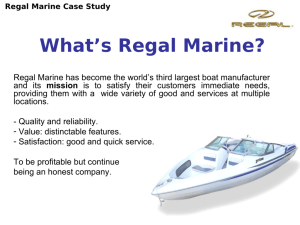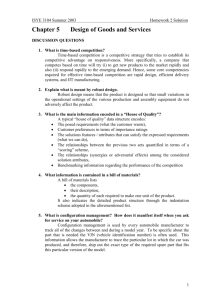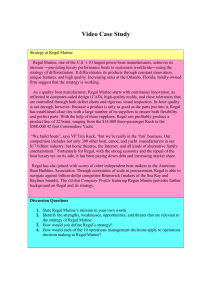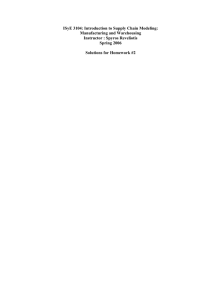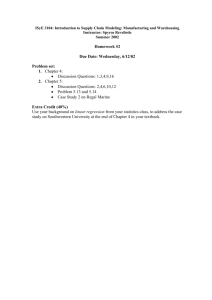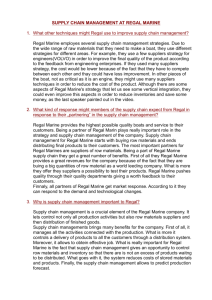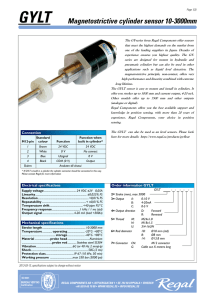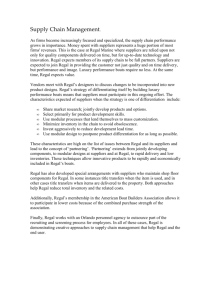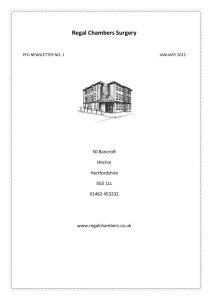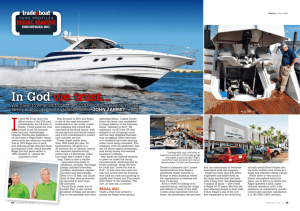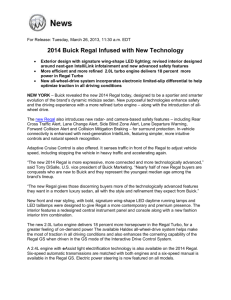Regal Marine: Product Strategy & Competitive Advantage
advertisement
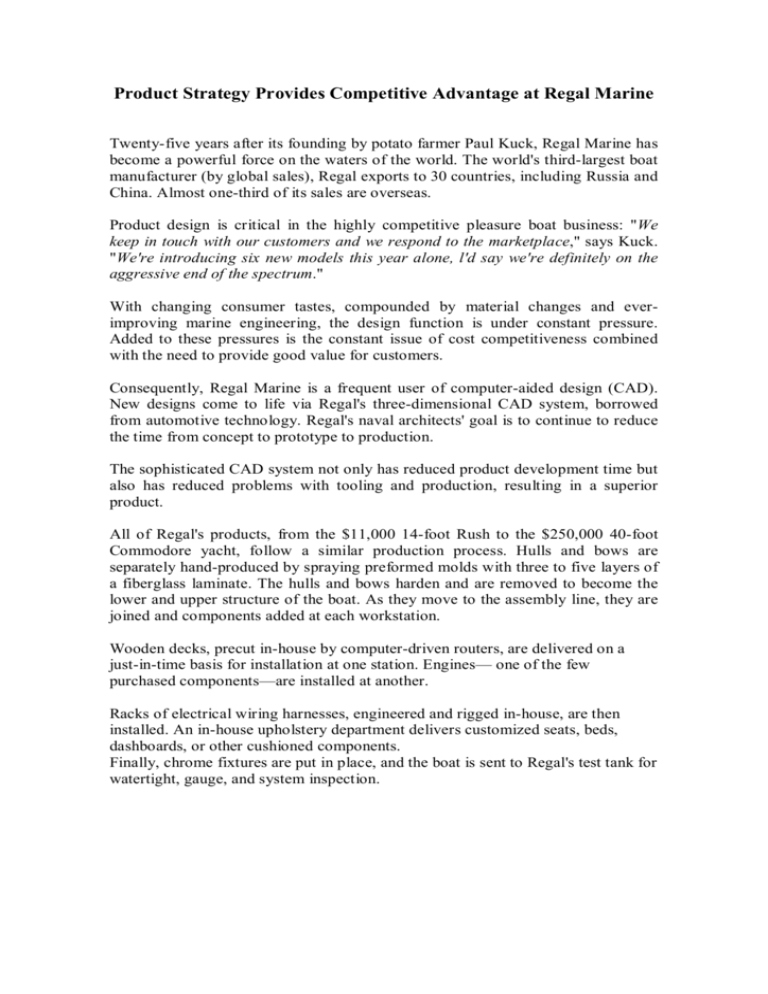
Product Strategy Provides Competitive Advantage at Regal Marine Twenty-five years after its founding by potato farmer Paul Kuck, Regal Marine has become a powerful force on the waters of the world. The world's third-largest boat manufacturer (by global sales), Regal exports to 30 countries, including Russia and China. Almost one-third of its sales are overseas. Product design is critical in the highly competitive pleasure boat business: "We keep in touch with our customers and we respond to the marketplace," says Kuck. "We're introducing six new models this year alone, l'd say we're definitely on the aggressive end of the spectrum." With changing consumer tastes, compounded by material changes and everimproving marine engineering, the design function is under constant pressure. Added to these pressures is the constant issue of cost competitiveness combined with the need to provide good value for customers. Consequently, Regal Marine is a frequent user of computer-aided design (CAD). New designs come to life via Regal's three-dimensional CAD system, borrowed from automotive technology. Regal's naval architects' goal is to continue to reduce the time from concept to prototype to production. The sophisticated CAD system not only has reduced product development time but also has reduced problems with tooling and production, resulting in a superior product. All of Regal's products, from the $11,000 14-foot Rush to the $250,000 40-foot Commodore yacht, follow a similar production process. Hulls and bows are separately hand-produced by spraying preformed molds with three to five layers of a fiberglass laminate. The hulls and bows harden and are removed to become the lower and upper structure of the boat. As they move to the assembly line, they are joined and components added at each workstation. Wooden decks, precut in-house by computer-driven routers, are delivered on a just-in-time basis for installation at one station. Engines— one of the few purchased components—are installed at another. Racks of electrical wiring harnesses, engineered and rigged in-house, are then installed. An in-house upholstery department delivers customized seats, beds, dashboards, or other cushioned components. Finally, chrome fixtures are put in place, and the boat is sent to Regal's test tank for watertight, gauge, and system inspection. CD-Rom Video Case 2 Product Design at Regal Marine With hundreds of competitors in the boat business, Regal Marine must work to differentiate itself from the flock. As we saw in the Global Company Profile that opened this chapter, Regal continuously introduces innovative, high-quality new boats. Its differentiation strategy is reflected in a product line consisting of 22 models. To maintain this stream of innovation, and with so many boats at varying stages of their life cycles, Regal constantly seeks design input from customers, dealers, and consultants, Design ideas rapidly find themselves in the styling studio, where they are placed onto CAD machines in order to speed the development process. Existing boat designs are always evolving as the company tries to stay stylish and competitive. Moreover, with life cycles as short as 3 years, a steady stream of new products is required. A few years ago, the new product was the three-passenger $ 11,000 Rush, a small but powerful boat capable of pulling a water-skier. This was followed with a 20-foot inboard-outboard performance boat with so many innovations that it won prize after prize in the industry. Another new boat is a redesigned 40-foot Commodore that sleeps six in luxury staterooms. With all these models and innovations, Regal designers and production personnel are under pressure to respond quickly. By getting key suppliers on board early and urging them to participate at the design stage, Regal improves both innovations and quality while speeding product development. Regal finds that the sooner it brings suppliers on board, the faster it can bring new boats to the market. After a development stage that constitutes concept and styling, CAD designs yield product specifications. The first stage in actual production is the creation of the "plug," a foam-based carving used to make the molds for fiberglass hulls and decks. Specifications from the CAD system drive the carving process. Once the plug is carved, the permanent molds for each new hull and deck design are formed. Molds take about 4 to 8 weeks to make and are all handmade. Similar molds are made for many of the other features in Regal boats—from galley and stateroom components to lavatories and steps. Finished molds can be joined and used to make thousands of boats. Discussion Questions 1. How does the concept of product life cycle apply lo Regal Marine products? Company has estimated that a life cycle of their products is 3 years. Their product line consisting of 22 models so they need new products as a steady stream. To maintain this stream of innovation and with so many boats at varying stages of their life cycles, Regal constantly seeks design input from customers, dealers, and consultants. They try to design, develop and produce ideas rapidly and launch new products on the markets as soon as possible. 2. What strategy does Regal use to stay competitive? Paul Kuck is said that: "We keep in touch with our customers and we respond to the marketplace. We're introducing six new models this year alone, l'd say we're definitely on the aggressive end of the spectrum." As the saying goes that customer is always right. Company listens to customers’ opinions and produce quickly products which there is demand. With changing consumer tastes, compounded by material changes and everimproving marine engineering, the design function is under constant pressure. Added to these pressures is the constant issue of cost competitiveness combined with the need to provide good value for customers. 3. What kind of engineering savings is Regal achieving by using CAD technology rather than traditional drafting techniques? Regal's naval architects' goal is to continue to reduce the time from concept to prototype to production. As the saying goes that time is money. The sophisticated CAD system not only has reduced product development time but also has reduced problems with tooling and production, resulting in a superior product. 4. What are the likely benefits of the CAD design technology? There are number of benefits of using CAD software. Some of the benefits are tangible for they are visible in the design process, which rooted in among others that design time is shorter. Other benefits are intangible which may not be visible directly but result in improvement in the quality of product, database availability, reduction of stress on the designers, better control over designing and production process as well as production cost are reduced. Source: Richard Bothom, 08.03.2010 and Design of Goods and Services, 2008 3D Design Software has developed no end of 2D-method. Key benefits of using 3D CAD design in mechanical and architectural industry are simplicity, automation and interactive analysis. Various problems have also left and design quality has received a major improvement. Source: 3D Cadcea Ltd, 08.03.2010 Sources: - Richard Bothom, 08.03.2010, http://fi.articlesnatch.com/Article/Benefits-Of-Using-3dCad-Design---3d-Modeling-Compared-To-2d-Method/890633 - 3D Cadcea Ltd, 08.03.2010, www.3d-cadcea.co.uk/html/benefits.htm - Prentice Hall, Inc, 2008, Operations Management presentation, chapter 5 – Design of Goods and Services,
